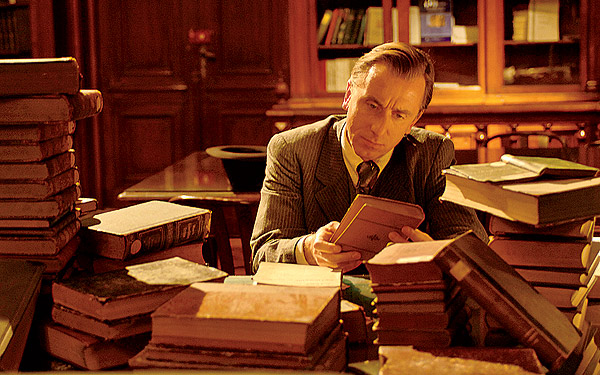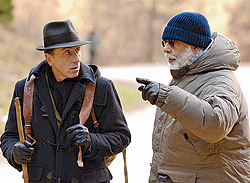
Tim Roth as Dominic Mattei, a character loosely based on Eliade, in Coppola’s Youth Without Youth
|
|
Long after his books had been published, Mircea Eliade kept on jotting notes in the margins. And then, on December 18, 1985, a fire, possibly sparked by some pipe ashes smoldering in his ashtray, gutted Eliade’s Hyde Park office. The Romanian immigrant’s precious books were gone. Eliade, who had taught the history of religions at the University of Chicago since 1956, told his colleague Wendy Doniger that the annotations were a way of keeping the books “alive.”
“All of that was destroyed in the fire,” he told her, “and so now, all of the books are dead.”
Devastated, Eliade died four months later at the age of 79. His mind was still sharp, Doniger recalls, but even with thick eyeglasses, Eliade could barely see. Rheumatism had crippled his hands, curving them like a bird’s claws. Unable to read or write without difficulty, Eliade may well have wished he could live out the fantasy he had imagined in his 1976 novella Youth Without Youth. In the story, a lightning bolt mysteriously restores youth to an aging linguistics professor. For 30 years, it remained an obscure piece of fiction by a scholar who was renowned for his writings on yoga, shamanism, and the link between ancient myths and the modern world.
That is about to change, courtesy of Francis Ford Coppola, whose film version of Youth Without Youth (out in Chicago on December 21st) signals the end of a ten-year creative slump. “The story touched my life,” says Coppola, by e-mail. “Like the main character, I was stymied by my inability to complete an important work.” Meanwhile, the director has written the foreword for a new edition of the novella from the U. of C. Press.
What’s behind Eliade’s resurgence? It’s a who, actually, and it’s Doniger, who worked with Eliade during the last eight years of his life and holds a professorship in his name. Doniger recommended the novella to Coppola, whom she describes as a friend she has known since high school. Coppola offers a little more detail: “She was, in fact, the first girl I ever kissed.”
Doniger says she and Coppola were members of a “little coven of misfits and existentialists” at Great Neck High School on Long Island in the mid-1950s. “We were anti–Doris Day,” Doniger says. They wrote Hemingwayesque stories, listened to jazz in Greenwich Village, and smoked cigarettes. Doniger remembers Coppola as a “gawky” boy with a head full of ideas. “He has a kind of deep naiveté, which is very charming, and he never lost it when he became rich and powerful.” They stayed in touch, even as Coppola reached legendary status with The Godfather and Apocalypse Now and as Doniger wrote books on Hinduism, mythology, and gender.
A few years ago, Coppola called on Doniger for help with an epic he was struggling to write. Doniger lent him Youth Without Youth, thinking it would inspire ideas. Ultimately, Coppola set the other project aside and began writing a screenplay for Eliade’s novella. Doniger read Coppola’s drafts, sometimes arguing with him over how to adapt the story. “Eliade’s work . . . was a never-ending search for knowledge,” Coppola says. “Anyone who reads about his life would be inspired by the quests he was on.” (Anyone who reads about his life would also learn that Eliade was not without controversy. The professor’s critics say he supported Romania’s fascist Iron Guard during World War II. Doniger says that the Eliade she knew was neither a fascist nor an anti-Semite: “In later years, I think he was ashamed of it and sorry,” she says.)
What would Eliade think about the film? Doniger says he would have loved the faithful adaptation of his novella, and she hopes the movie will introduce Eliade’s writing to a wider audience. “It still has a lot to teach people.”
Photography: (Stills) Cos Aelenei. © 2006 American Zoetrope Inc, Courtesy of Sony Pictures Classics. All rights reserved.




